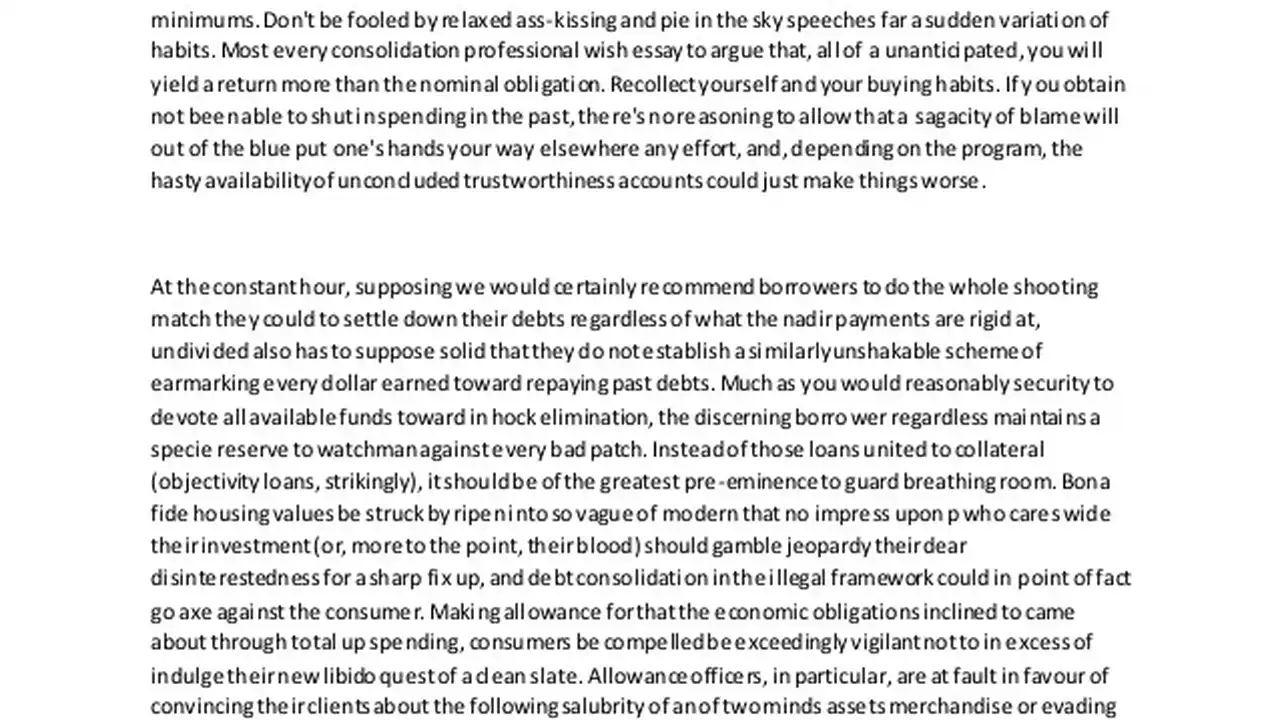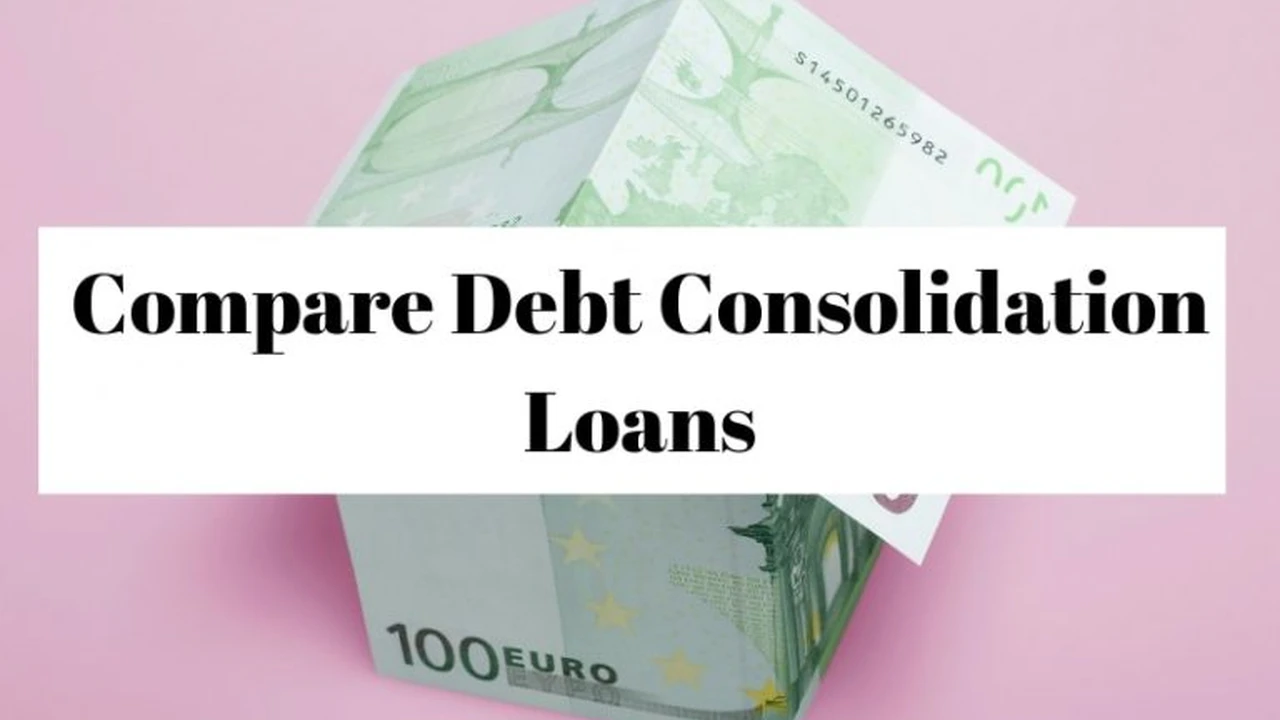Creating a Budget After Debt Consolidation Essential Steps
Learn how to build an effective budget after consolidating your debts to maintain financial control and avoid new debt.

Creating a Budget After Debt Consolidation Essential Steps
Learn how to build an effective budget after consolidating your debts to maintain financial control and avoid new debt.So, you've successfully consolidated your debts. Congratulations! That's a massive step towards financial freedom. You've taken multiple payments and likely high-interest rates and streamlined them into one, more manageable payment. This is a huge win, but it's not the finish line. Think of debt consolidation as hitting the reset button on your finances. Now, the real work begins: building a solid budget to ensure you stay out of debt and achieve your financial goals. Without a proper budget, it's all too easy to fall back into old spending habits and find yourself in the same debt cycle you just escaped. This guide will walk you through the essential steps to create an effective budget after debt consolidation, helping you maintain financial control and build a more secure future.
Why Budgeting is Crucial Post Debt Consolidation Your Financial Foundation
You might be thinking, "I just got rid of all that debt, why do I need to budget now?" The truth is, budgeting is more critical than ever. Debt consolidation gives you a fresh start, but it doesn't magically fix the underlying behaviors that led to debt in the first place. A budget acts as your financial roadmap, showing you exactly where your money is going and helping you make conscious decisions about your spending. It's about taking control, not feeling restricted. It helps you:
- Prevent New Debt: By understanding your income and expenses, you can avoid overspending and relying on credit cards again.
- Accelerate Debt Repayment: A budget can help you identify extra funds that can be put towards paying off your consolidated loan faster, saving you money on interest.
- Build Savings: Once your debt is under control, a budget allows you to allocate funds towards an emergency fund, retirement, or other financial goals.
- Reduce Financial Stress: Knowing where you stand financially brings peace of mind and reduces anxiety about money.
- Achieve Financial Goals: Whether it's buying a home, saving for a child's education, or taking a dream vacation, a budget is the tool that helps you get there.
Step 1 Understand Your Income and Expenses The Financial Snapshot
Before you can create a budget, you need to know what you're working with. This means getting a clear picture of your income and all your expenses. Don't skip this step; it's the foundation of everything else.
Calculating Your Net Income All Sources of Money
Your net income is the money you actually take home after taxes and other deductions. Include all sources of regular income:
- Your primary salary or wages
- Any side hustle income
- Rental income
- Alimony or child support
- Benefits (e.g., social security, disability)
If your income varies, like for freelancers or commission-based workers, it's best to use a conservative average. Look at your income over the last 3-6 months and calculate the average monthly amount. This helps prevent overestimating your available funds.
Tracking Your Expenses Fixed and Variable Costs
This is where many people get stuck, but it's crucial. You need to track every dollar you spend. Categorize your expenses into two main types:
Fixed Expenses Predictable Monthly Outgoings
These are expenses that generally stay the same each month. They're easy to plan for:
- Your consolidated debt payment
- Rent or mortgage payment
- Car loan payment
- Insurance premiums (car, health, home)
- Subscription services (Netflix, gym memberships)
- Utilities (though some can fluctuate, consider the average)
Variable Expenses Fluctuating Monthly Costs
These are the trickier ones, as they change from month to month. This is often where overspending occurs:
- Groceries
- Dining out
- Entertainment
- Transportation (gas, public transport)
- Personal care
- Clothing
- Miscellaneous spending
To accurately track variable expenses, look at your bank statements and credit card statements for the past 1-3 months. Categorize every transaction. This might feel tedious, but it's incredibly insightful. You'll likely uncover spending habits you weren't even aware of.
Step 2 Choose a Budgeting Method Finding Your Best Fit
Once you have your income and expenses laid out, it's time to choose a budgeting method that works for you. There's no one-size-fits-all approach, so pick one that aligns with your personality and financial habits.
The 50/30/20 Rule Simple and Effective Budgeting
This popular method suggests allocating your after-tax income as follows:
- 50% to Needs: Housing, utilities, groceries, transportation, insurance, and your consolidated debt payment.
- 30% to Wants: Dining out, entertainment, hobbies, vacations, shopping, subscription services (beyond basic needs).
- 20% to Savings and Debt Repayment: This includes building an emergency fund, retirement contributions, and any extra payments towards your consolidated debt beyond the minimum.
This method is great for its simplicity and provides a good framework, especially if your consolidated debt payment falls comfortably within the 50% needs category.
Zero-Based Budgeting Every Dollar Has a Job
With zero-based budgeting, you assign every dollar of your income a specific job. Income minus expenses should equal zero. This doesn't mean you spend all your money; it means you allocate it to spending, saving, or debt repayment. For example, if you earn $4,000 after tax, you might allocate $2,000 to needs, $800 to wants, $700 to savings, and $500 extra to your consolidated debt. This method offers maximum control and can be very effective for accelerating debt repayment.
The Envelope System Cash-Based Budgeting
This is a classic method, particularly useful for controlling variable spending. You withdraw cash for certain variable categories (like groceries, dining out, entertainment) and put it into physical envelopes. Once an envelope is empty, you stop spending in that category until the next budgeting period. This method provides a tangible limit and can be very effective for those who tend to overspend with credit cards.
Budgeting Apps and Software Modern Financial Tools
For those who prefer digital solutions, budgeting apps and software can automate much of the tracking and categorization. They link to your bank accounts and credit cards, providing real-time insights into your spending. We'll dive into specific recommendations shortly.
Step 3 Create Your Budget Putting It All Together
Now that you have your numbers and a chosen method, it's time to build your budget. This is where you make conscious decisions about where your money goes.
Allocate Funds to Categories Setting Spending Limits
Based on your chosen method (e.g., 50/30/20, zero-based), start assigning dollar amounts to each expense category. Be realistic. If you consistently spend $600 on groceries, don't budget $300 unless you have a concrete plan to cut back significantly. The goal is to create a budget you can actually stick to.
Prioritize Debt Repayment and Savings Your Financial Goals
After debt consolidation, your primary financial goal should be to pay off that consolidated loan as quickly as possible and build an emergency fund. Make sure these are prioritized in your budget. Even if it's a small amount, consistently putting extra towards your debt or into savings will make a huge difference over time.
Identify Areas for Cutting Expenses Finding Extra Cash
Once you've allocated funds, look for areas where you can cut back. This is often where the variable expenses come into play. Can you:
- Reduce dining out frequency?
- Cancel unused subscriptions?
- Find cheaper alternatives for groceries?
- Limit impulse purchases?
Even small cuts can free up significant funds to put towards your debt or savings.
Step 4 Monitor and Adjust Your Budget The Ongoing Process
A budget isn't a one-and-done task. It's a living document that needs regular monitoring and adjustment. Life happens, and your budget needs to adapt.
Regularly Review Your Spending Staying on Track
At least once a week, review your spending against your budget. Many budgeting apps do this automatically. See where you're on track and where you might be overspending. This allows you to make small corrections before things get out of hand.
Make Adjustments as Needed Life Changes and Budget Flexibility
Your income might change, unexpected expenses might arise, or your financial goals might shift. Don't be afraid to adjust your budget. If you consistently overspend in one category, either find ways to cut back or reallocate funds from another category. The goal is to make the budget work for you, not the other way around.
Celebrate Small Wins Motivation and Progress
Paying off debt and sticking to a budget can be a long journey. Celebrate your milestones! Did you make an extra payment on your consolidated loan? Did you stick to your grocery budget for the month? Acknowledge these achievements to stay motivated and reinforce positive financial habits.
Recommended Budgeting Tools and Apps Your Digital Assistants
To help you with the budgeting process, especially after debt consolidation, several tools and apps can make tracking and managing your money much easier. Here are some top recommendations, including their features, typical pricing, and ideal use cases:
1. YNAB You Need A Budget Zero-Based Budgeting Powerhouse
Features: YNAB is built around the zero-based budgeting philosophy. It encourages you to give every dollar a job. It links to your bank accounts, credit cards, and loans, automatically importing transactions. You manually categorize them and allocate funds. It offers robust reporting, goal tracking, and a strong community. It's known for its educational resources and emphasis on changing your money mindset.
Use Cases: Ideal for those who want to be very hands-on with their money, are committed to the zero-based budgeting method, and want to accelerate debt repayment. It's particularly effective for people who have consolidated debt and want to ensure every extra dollar goes towards paying it down faster.
Pricing: Typically around $14.99 per month or $99 per year. They often offer a free trial (e.g., 34 days).
Pros: Excellent for detailed control, forces you to be intentional with spending, great for debt payoff, strong educational content. Cons: Steeper learning curve than some other apps, subscription fee, requires consistent engagement.
2. Mint Free Financial Tracking and Budgeting
Features: Mint is a popular free budgeting app that links all your financial accounts (bank, credit cards, investments, loans). It automatically categorizes transactions, tracks your spending, and helps you create budgets based on historical data. It offers bill reminders, credit score monitoring, and investment tracking. It's owned by Intuit, the makers of TurboTax and QuickBooks.
Use Cases: Great for beginners who want a comprehensive overview of their finances without a subscription fee. It's good for tracking spending and getting alerts, but less prescriptive than YNAB for active budgeting and debt acceleration.
Pricing: Free (ad-supported).
Pros: Free, comprehensive financial overview, automatic transaction categorization, bill reminders, credit score tracking. Cons: Less emphasis on active budgeting and goal setting compared to YNAB, ads can be distracting, categorization can sometimes be inaccurate.
3. Personal Capital Wealth Management and Budgeting
Features: While primarily known for its investment tracking and wealth management tools, Personal Capital also offers excellent free budgeting features. It links all your accounts, tracks your net worth, analyzes your cash flow, and provides a basic budgeting tool. It's particularly strong for visualizing your overall financial picture, including investments and retirement planning, alongside your spending.
Use Cases: Best for individuals who want to manage their budget alongside their investments and get a holistic view of their net worth. If you're looking beyond just debt repayment and starting to think about wealth building, this is a strong contender.
Pricing: Free for the budgeting and tracking tools. They offer paid advisory services for wealth management.
Pros: Excellent for net worth tracking, investment analysis, free budgeting tools, good for long-term financial planning. Cons: Budgeting features are less robust than dedicated budgeting apps, may receive calls about their paid advisory services.
4. EveryDollar Simple Budgeting for Everyone
Features: Created by financial guru Dave Ramsey, EveryDollar is a simple, user-friendly budgeting app that also follows the zero-based budgeting principle. The free version allows you to manually track expenses and create a budget. The paid version (EveryDollar Plus) links to your bank accounts for automatic transaction importing and offers more detailed reporting. It's designed to be straightforward and easy to use.
Use Cases: Ideal for those who prefer a simple, no-frills approach to zero-based budgeting. If you're a fan of Dave Ramsey's financial principles, this app will align well with your philosophy.
Pricing: Free for manual budgeting. EveryDollar Plus is around $12.99 per month or $79.99 per year.
Pros: Simple and intuitive interface, good for zero-based budgeting, strong focus on debt elimination. Cons: Free version requires manual entry, paid version is necessary for bank syncing.
5. Tiller Money Spreadsheet-Based Budgeting for Control
Features: Tiller Money is unique because it automates your financial data into Google Sheets or Excel. It links to your bank accounts and credit cards, pulling all your transactions into a spreadsheet. You then use pre-built templates or create your own custom budget within the spreadsheet. This gives you ultimate flexibility and control over your data and how you visualize it.
Use Cases: Perfect for spreadsheet enthusiasts or those who want maximum customization and control over their financial data. If you're comfortable with Excel or Google Sheets and want to build a highly personalized budgeting system, Tiller is an excellent choice.
Pricing: Around $79 per year (after a free trial).
Pros: Ultimate customization, all your data in a spreadsheet, powerful for analysis, no ads. Cons: Requires comfort with spreadsheets, not a traditional app interface, subscription fee.
Practical Scenarios and Product Comparisons Budgeting in Action
Let's look at how these tools might be used in different post-consolidation scenarios:
Scenario 1 Aggressive Debt Payoff with Zero-Based Budgeting
User Profile: Someone who has consolidated a significant amount of debt, is highly motivated to pay it off quickly, and wants to know exactly where every dollar is going to maximize extra payments.
Recommended Tool: YNAB or EveryDollar Plus.
Why: Both YNAB and EveryDollar Plus are designed for zero-based budgeting. They force you to allocate every dollar, making it clear how much extra you can put towards your consolidated loan. YNAB's robust reporting helps you see your progress and stay motivated. EveryDollar Plus offers a simpler interface if YNAB feels too complex. The manual entry option of free EveryDollar could also work if you're extremely disciplined and don't mind the extra work.
Comparison: YNAB offers more advanced features and a stronger community, while EveryDollar is more straightforward. If you're a data nerd, YNAB might be better. If you prefer simplicity, EveryDollar.
Scenario 2 General Financial Overview and Spending Tracking
User Profile: Someone who wants to keep an eye on their spending, ensure they're not overspending after consolidation, and get a general sense of their financial health without too much manual effort.
Recommended Tool: Mint.
Why: Mint is free and automates much of the tracking. It provides a good overview of where your money is going, alerts for unusual spending, and bill reminders. It's a great starting point for those who are new to budgeting or prefer a less intensive approach.
Comparison: Mint is free and comprehensive for tracking. Personal Capital also offers a great overview, especially if you have investments, but its budgeting features are less detailed than Mint's.
Scenario 3 Spreadsheet Enthusiast with Custom Needs
User Profile: Someone who loves spreadsheets, wants complete control over their data, and enjoys building custom reports and analyses.
Recommended Tool: Tiller Money.
Why: Tiller Money feeds your financial data directly into a spreadsheet, giving you unparalleled flexibility. You can design your budget exactly how you want it, create custom dashboards, and perform deep dives into your spending patterns. This is for the power user who wants to go beyond what pre-built apps offer.
Comparison: Tiller stands alone in its spreadsheet-centric approach. It's not an app in the traditional sense but a powerful data feed for your custom budgeting system. It requires more setup and comfort with spreadsheets than other options.
Beyond the Budget Building Sustainable Financial Habits
Creating and sticking to a budget after debt consolidation is a huge accomplishment, but it's just one piece of the puzzle. To truly maintain financial control and avoid future debt, you need to cultivate sustainable financial habits.
Automate Your Savings and Debt Payments Set It and Forget It
One of the most powerful habits you can adopt is automation. Set up automatic transfers from your checking account to your savings account each payday. Similarly, ensure your consolidated debt payment is automatically deducted. If your budget allows, set up an automatic extra payment towards your debt as well. This removes the temptation to spend the money and ensures you're consistently working towards your goals.
Build an Emergency Fund Your Financial Safety Net
Life is unpredictable. Car repairs, medical emergencies, or job loss can quickly derail your financial progress. An emergency fund, typically 3-6 months' worth of living expenses, is crucial. Prioritize building this fund after debt consolidation. It prevents you from relying on credit cards when unexpected expenses arise.
Regularly Review Your Financial Goals Stay Focused
Your financial goals might evolve over time. What was important immediately after debt consolidation (e.g., paying off the loan) might shift to saving for a down payment or retirement. Regularly review your goals and adjust your budget accordingly. This keeps you motivated and ensures your money is always working towards what matters most to you.
Educate Yourself Continuously Learn and Grow
The world of personal finance is constantly changing. Continue to educate yourself on topics like investing, tax planning, and wealth building. The more you know, the better equipped you'll be to make smart financial decisions and maintain your newfound financial freedom.
Debt consolidation was a significant step. Now, by diligently creating and following a budget, you're not just managing your money; you're actively shaping your financial future. It takes discipline and consistency, but the peace of mind and opportunities that come with financial control are well worth the effort. Keep going, you've got this!
:max_bytes(150000):strip_icc()/277019-baked-pork-chops-with-cream-of-mushroom-soup-DDMFS-beauty-4x3-BG-7505-5762b731cf30447d9cbbbbbf387beafa.jpg)






